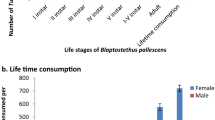Abstract
The pest status of the red cotton bug, Dysdercus koenigii (Fab.) has been changing due to the climatic changes, and appearances of new natural enemies in cotton agro-ecosystems. As a specialized predator of Dysdercus bugs, Antilochus coquebertii (Fab.) has been known, and is abundant now in cotton fields in Tamil Nadu, India. Therefore we investigated its predatory behavior and the preference against prey developmental stage in order to evaluate its performance as a natural enemy against D. koenigii. The predatory behavior of A. coquevertii adults consisted of seven feeding acts; i.e., arousal, approaching, capturing, rostral probing, paralyzing, feeding and post-feeding. Adult males were quicker than females in predatory acts including aroused, approached, captured, probed the prey by rostrum, paralyzed, and post-predatory behaviors. The predators exhibited an active hunting behavior, in which they seem to have used both olfactory and visual stimuli for orientation to the prey. The results of the prey-choice test exhibited that the second, third, fourth and fifth nymphal-stage and adult predator has a reproductive-stage preference to the second, third, fourth and fifth nymphal-stage and adult prey, respectively. The results implies that the synchronization between the occurrence of the prey and the predator could have significance for the control of the pest using the predator.

Similar content being viewed by others
References
Bell AM, Hankison SJ, Laskowski KL (2009) The repeatability of behaviour, a meta-analysis. Anim Behav 77:771–783
Chauthani AR, Misra US (1966) Observations on the life history of Antilochus coqueberti, a predator of Dysdercus koenigi. J Econ Entomol 59:767–768
Evangelin G, Horne B, Jino M, John William S (2015) Feeding behaviour of Antilochus coquebertii (Hemiptera, Pyrrhocoridae) and its systematic positioning. J Entomol Zool Stud 3(1):199–203
Kamble ST (1974) Notes on a predator of Dysdercus koengii (Fabr.) (Hemiptera , Pyrrhocoridae). Curr Sci 49:151
Kodandaram MH, Thukar NSA, Shylesha AN (2008) Toxicity and morphogenetic effect of different botanicals of red cotton bug Dysdercus koenigii Fab. (Hemiptera , Pyrrhocoridae) in north eastern Hill region of India. J Biopest 1(2):187–189
Kohno K (2003) Development and reproduction of Antilochus coqueberti (Heteroptera, Pyrrhocoridae), the specific predator of Dysdercus spp. (Heteroptera, Pyrrhocoridae). Appl Entomol Zool 38:103–108. https://doi.org/10.1303/aez.2003.103
Kohno K, Takahashi K, Sakakibara M (2002) New prey–predator association in aposematic pyrrhocorid bugs, Antilochus coqueberti as a specialist predator on Dysdercus species. Entomol Sci 5:391–397
Kohno K, Bui Thi N, Fujiwara M (2004) Predation of Dysdercus cingulatus (Heteroptera, Pyrrhocoridae) by the specialist predator Antilochus coqueberti (Heteroptera, Pyrrhocoridae). Appl Entomol Zool 39:661–667. https://doi.org/10.1303/aez.2004.661
Lu Y, Wu K, Jiang Y, Guo Y, Desneux N (2012) Widespread adoption of Bt cotton and insecticide decrease promotes biocontrol services. Nature 487(7407):362–365
Mishra M, Chakraborty I, Basu S (2019) A study of the role of vision in the foraging behaviour of the pyrrhocorid bug Antilochus conquebertii (Insecta; Hemiptera; Pyrrhocoridae). Invertebr Neurosci 19:2. https://doi.org/10.1007/s10158-018-0222-6
Muhammad S, Muhammad S, Syed MZ (2020) Survival and fecundity of Antilochus coquebertii (Hemiptera: Pyrrhocoridae) on different stages of Dysdercus koenigii (Hemiptera: Pyrrhocoridae). J Kansas Entomol Soc 92(3):526–535
Naqqash MN, Saeed S, Jaleel W, Zaka SM, Saeed Q (2014) Effect of host plants on life history traits of Dysdercus koenigii (Hemiptera, Pyrrhocoridae). J Biodivers Environ Sci 4(1):187–194
Saeed R, Naveed M, Razaq M, Rafiq M, Jan MT, Shah SIA, Munir F (2020) Biology of newly recorded predator Antilochus coquebertii of red cotton bug, Dysdercus koenigii Fabricius (Hemiptera: Pyrrhocoridae) from Pakistan. Pakistan J Zool 52(5):2011–2013
Sahayaraj K, Fernandez SM (2017) Life traits and predatory potential of Antilochus coqueberti (Fab.)(Heteroptera: Pyrrhocoridae) against Dysdercus koenigii Fab. J Asia Pac Entomol 20(4):1314–1320
Sahayaraj K, Kumar V, Avery P (2015) Functional response of Rhynocoris kumarii (Heteroptera, Reduviidae) on Phenacoccus solenopsis (Hemiptera, Pseudococcidae) in the laboratory. Eur J Entomol 112(1):69–74
Saxena KN (1963) Mode of ingestion in a heteropterous insect Dysdercus koenigii (F.) (Pyrrhocoridae). J Insect Physiol 9(1):47–71
Schaefer CW, Ahmad I (1987) Parasites and predators of Pyrrhocoroidea (Hemiptera) of cotton stainers by Phonoctonus spp. (Hemiptera, Reduyiidae). Entomophaga 32:269–275
Varma HS, Patel RK (2012) Biology of red cotton bug (Dysdercus koenigii). Agres Int e-J 1:148–156
Veettil PC, Krishna VV, Qaim M (2016) Ecosystem impacts of pesticide reductions through Bt cotton adoption. Aust J Agric Resour Econ 60:1–20
Waterhouse, D.F. (1998). Biological Control of Insect Pests, Southeast Asian Prospects Australian Centre for International Agricultural Research Canberra, PP 536 (1998)
Yasuda T (2000) Role of semiochemicals in prey-locating behavior of a generalist predatory stink bug, Eocanthecona furcellata (Wolff) (Heteroptera: Pentatomidae). Japan Agric Res Quart 34(1):15–20
Acknowledgements
The senior author thanks the Ministry of Environment and Forest, Govt. of India for finanaical assitance (Ref No. MRDF/01/33/P/07). We sincerely thank Dr. Kohno, Katsuyuki, Japan; F. Molleman, Indian Institute of Science Education and Research Thiruvananthapuram and Vivek Kumar, University of Florida, USA for the consistent improvement of the manuscript. We further thank The Management, St. Xavier’s College, Palayamkottai for institutional facilities and encouragements.
Author information
Authors and Affiliations
Contributions
KS and SMF conceived the study, designed the methodology, and collected and analyzed the data; KS interpreted the results and drafted the manuscript; KS and SMF revised the manuscript. Both authors gave final approval for publication.
Corresponding author
Ethics declarations
Statement on competing interest
The manuscript is very much useful for entomologists working in insect ethology and biological control programmes.
Conflict of interest
The authors declare that they have no competing interests.
Ethical approval
All applicable international, national, and/or institutional guidelines for the care and use of animals were followed.
Additional information
Publisher’s note
Springer Nature remains neutral with regard to jurisdictional claims in published maps and institutional affiliations.
Rights and permissions
About this article
Cite this article
Sahayaraj, K., Fernandez, S.M. The predation behavior and the prey size preferences of Antilochus coquebertii (Pyrrhocoridae) against Dysdercus koenigii (Pyrrhocoridae). Int J Trop Insect Sci 41, 1763–1769 (2021). https://doi.org/10.1007/s42690-020-00387-2
Received:
Accepted:
Published:
Issue Date:
DOI: https://doi.org/10.1007/s42690-020-00387-2




